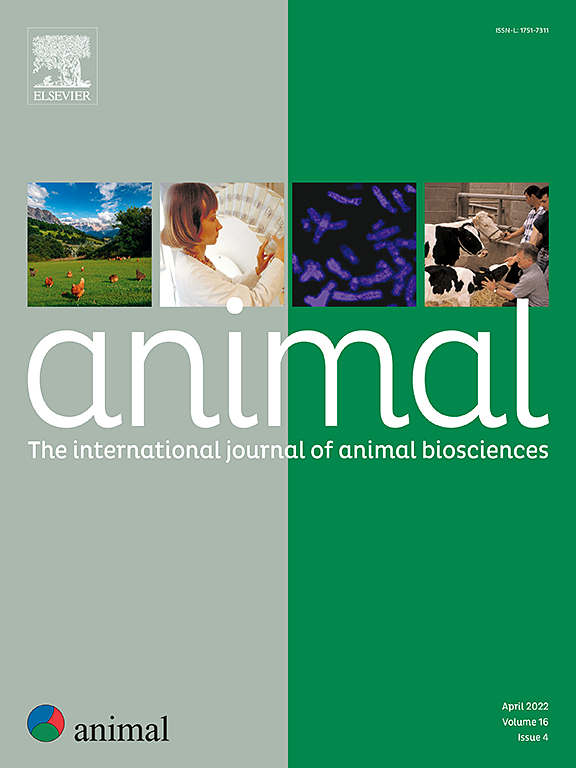颈带相对于奶牛体型的位置对奶牛卧隔间内起身、躺卧和排便行为的影响
IF 4
2区 农林科学
Q1 AGRICULTURE, DAIRY & ANIMAL SCIENCE
引用次数: 0
摘要
在奶牛的小隔间饲养系统中,使用颈栏/皮带/链条来限制粪便和尿液污染床上用品。灵活的颈带是刚性颈轨的替代品,刚性颈轨与动物福利问题有关,如痛苦的碰撞、受伤和非典型行为。然而,没有文献存在的柔性颈带的定位有关其在限制床上材料的污染及其对奶牛行为的影响的有效性。在一个有40头奶牛的牲口棚中,我们通过实验研究了颈带相对于奶牛体型的位置如何影响奶牛的起身和躺卧行为、一般躺卧行为和躺卧隔间中的排便行为。为了扩大身体相对定位的范围,我们在两个实验中改变了颈带的高度(105、120和135厘米)和颈带与马路边的距离(155和170厘米)。结果表明,颈带高度与马肩高之比(NSH ratio)为0.65 ~ 0.96,颈带距马路边距离与体对角线长度之比(NSD ratio)为0.85 ~ 1.11。在整个研究过程中,除了侧头向前冲外,非典型的上升和躺下行为很少见。较高(较少限制)的NSH比率与上升过程中腕关节向后爬行的可能性降低有关。我们没有发现相对于牛体型的颈带位置对其他非典型起床和躺下行为的概率或每天躺下的时间和频率的影响的统计支持。对于在上升事件前后120秒内的排便,而在躺着的隔间,更高(更少的限制)的NSH比率与更高的粪便落在隔间的可能性相关。NSD比率越高(限制越少),这种可能性也越高。总体而言,我们的研究结果表明,在本研究中,柔性颈带相对于奶牛体型的位置并没有显著影响奶牛的行为,这表明柔性颈带可以适应不同体型的奶牛。将奶牛安置在躺卧隔间中,以这种方式限制在上升事件周围弄脏床上用品的效果随着NSH比率的降低(更具限制性)而增加。因此,灵活的颈带可以成为刚性颈轨的可行替代方案,通过限制在上升事件周围的躺卧隔间的污染,而不会大大阻碍奶牛在上升和躺下期间的运动。本文章由计算机程序翻译,如有差异,请以英文原文为准。
The effect of neck strap positioning relative to dairy cow body size on rising, lying down, and defecation behaviour in lying cubicles
In cubicle housing systems for dairy cows, neck rails/straps/chains are used to limit bedding soiling by faeces and urine. Flexible neck straps are an alternative to rigid neck rails, which are associated with animal welfare issues such as painful collisions, injuries, and atypical behaviours. However, no literature exists on the positioning of flexible neck straps in relation to their effectiveness in limiting soiling of the bedding material and their effect on cow behaviour. In a research barn with 40 cows, we experimentally investigated how neck strap positioning relative to cow body size affects rising and lying down behaviours, general lying behaviour, and defecation behaviour in lying cubicles. To expand the range of body-relative positioning beyond that resulting from the herd’s variation in body size, we varied the neck strap height (105, 120, and 135 cm) and its distance from the curb (155 and 170 cm) in two experiments. The resulting ratios of neck strap height to withers height (NSH ratio) ranged from 0.65 to 0.96, and the ratios of neck strap distance from the curb to diagonal body length (NSD ratio) ranged from 0.85 to 1.11. With the exception of sideways head lunging, atypical rising and lying down behaviours were rare throughout the study. A higher (less restrictive) NSH ratio was associated with a reduced probability of crawling backwards on the carpal joints during rising. We found no statistical support for an effect of neck strap positioning relative to cow body size on the probabilities of other atypical rising and lying down behaviours, or daily lying time and frequency. For defecations within a 120 s time window around rising events while in the lying cubicle, a higher (less restrictive) NSH ratio was associated with a higher probability of faeces landing in the cubicle. This probability also increased with a higher (less restrictive) NSD ratio. Overall, our results indicate that the positioning of flexible neck straps relative to cow body size, as tested in this study, does not considerably affect dairy cow behaviour, suggesting that flexible straps can accommodate cows of different sizes. The effectiveness of positioning cows in the lying cubicle in such a way that limits soiling of the bedding around rising events increased with a lower (more restrictive) NSH ratio. Thus, flexible neck straps can be a viable alternative to rigid neck rails by limiting soiling of lying cubicles around rising events without considerably impeding dairy cow movements during rising and lying down.
求助全文
通过发布文献求助,成功后即可免费获取论文全文。
去求助
来源期刊

Animal
农林科学-奶制品与动物科学
CiteScore
7.50
自引率
2.80%
发文量
246
审稿时长
3 months
期刊介绍:
Editorial board
animal attracts the best research in animal biology and animal systems from across the spectrum of the agricultural, biomedical, and environmental sciences. It is the central element in an exciting collaboration between the British Society of Animal Science (BSAS), Institut National de la Recherche Agronomique (INRA) and the European Federation of Animal Science (EAAP) and represents a merging of three scientific journals: Animal Science; Animal Research; Reproduction, Nutrition, Development. animal publishes original cutting-edge research, ''hot'' topics and horizon-scanning reviews on animal-related aspects of the life sciences at the molecular, cellular, organ, whole animal and production system levels. The main subject areas include: breeding and genetics; nutrition; physiology and functional biology of systems; behaviour, health and welfare; farming systems, environmental impact and climate change; product quality, human health and well-being. Animal models and papers dealing with the integration of research between these topics and their impact on the environment and people are particularly welcome.
 求助内容:
求助内容: 应助结果提醒方式:
应助结果提醒方式:


